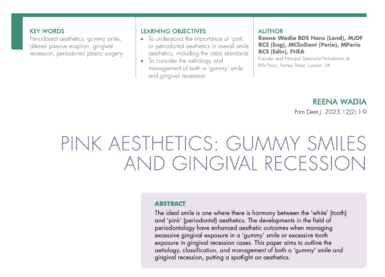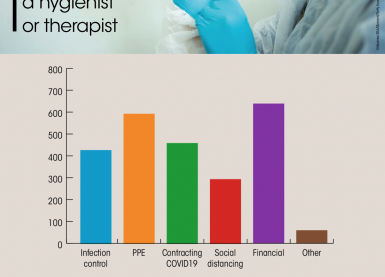Home/Articles
/ General Dental /
Reena’s Notes: 20 Key Points on Dentine Hypersensitivity with Professor Nicola West
February 10, 2015

- Dentine hypersensitivity (DH) is characterised by a short, sharp, pain arising from exposed dentine in response to stimuli, typically thermal, evaporative, tactile, osmotic or chemical, which cannot be ascribed to any other form of dental defect or pathology (Holland et al 1997).
- DH is distressing and can affect the quality of life of our patients.
- DH is difficult condition to treat and the Canadian consensus report indicated that practitioners are seeking guidance on managing DH in practice.
- There is a huge variation in the incidence of DH due to the design of the studies. A practice-based study of 18-35 year olds found an incidence of 42% (West 2013).
- Messages from general health professionals includes consumption of 5 or 7 portions of fruit and vegetables a day. Since 1980, there has also been a 3-fold increase in the intake of soft acidic beverages. Along with the change in diet, people are keeping their teeth for longer and so we are likely to see a rise in the incidence of DH. For this reason it is important we employ preventative strategies for all our patients.
- DH is also documented from occlusal dentine exposure in some countries e.g. Germany but not often in the UK.
- The most widely accepted theory of how DH pain occurs is Brannstrom’s hydrodynamic theory, which describes the fluid movement within the dentinal tubules.
- For DH to occur you need: dentine exposure (lesion localisation) and tubule exposure (lesion initiation). Dentine exposure can occur by soft tissue loss (gingival recession) or hard tissue loss (abrasion and erosion). Tubule exposure can occur via abrasion or more commonly erosion.
- In practice, tooth wear can be scored using BEWE (Basic Erosive Wear Examination) developed by D. Bartlett, C. Ganss and A. Lussi (2008). This assesses wear above or below 50% for each surface. A 4-point scale is used (0,1,2 and 3). All teeth are examined and the most severely worn surface in a sextant is scored.
- 30% of European young adults have toothwear. BEWE scores 2 or 3 affected 26.1% and 3.3% respectively of the participants on at least one tooth.
- Risk factors for tooth wear are similar to DH – citrus fruits, acidic soft drinks, heartburn and overzealous toothbrushing.
- Management of DH – ensure you have made the correct diagnosis then identify and modify/eliminate the aetiological and predisposing factors (erosion, toothbrushing with toothpaste, periodontal disease). Provide and recommend proven efficacious products.
- Treatment of patients with DH can be through over the counter or professionally applied products:
a) Nerve desensitisation e.g. potassium (toothpaste, mouthwash)
b) Tubule occlusion – toothpaste, prophylaxis paste, professional applied
c) Dentine adhesive sealers e.g. glass ionomers, restorations
d) Protection against erosion of enamel (and therefore dentine) through e.g. stannous fluoride
e) Lasers
f) Periodontal surgery - Nerve stabilisation using potassium – Cochrane review (Poulsen et al 2001) – mechanism inconclusive but some evidence supporting potassium-containing toothpastes.
- Tubule occlusion – creation of a smear layer, abrasive/actives in tubules. Sound evidence for: stannous fluoride, strontium acetate, arginine/calcium carbonate, calcium sodium phosphosilicate.
- New product in the USA – Crest Sensi Stop Strips – may be coming to the UK soon.
- Toothpastes should be the first line of treatment and if this doesn’t work then move onto professionally applied products.
- Findings from systematic reviews:
i) Laser therapy does reduce DH pain but the evidence is weak and there is a strong placebo effect (Sgolastra et al 2011).
ii) The evidence for oxalates in reducing DH is largely unsupportive (Cunha-Cruz et al 2011).
iii) The quantity and quality of clinical trial evidence are insufficient to make conclusions regarding the long-term effectiveness of casein derivatives, specifically CPP-ACP, in treating DH (Azarpazahooh & Limeback 2008).
iv) Arginine toothpastes are associated with reduction in DH but there are limitations to current studies (Yan et al 2013).
v) Efficacy of arginine demonstrated but few studies (Sharif et al 2013).
vi) There is insufficient evidence to state categorically whether strontium or potassium salts per se are effective in reducing DH (Karim & Gillam 2013).
vii) No agent preference (Lin P-Y et al 2013). - The findings from the latest systematic review by West et al (2014), which was discussed at the European Workshop, will be published shortly in the Journal of Clinical Periodontology.
- Further reading on the diagnosis and management of dentine hypersensitivity:
– Canadian Advisory Board on Dentine Hypersensitivity 2003. Journal of the Canadian Dental Association 2003; 69(4):221-6.
– Amarasena et al. Dentine hypersensitivity – Australian dentists’ prespective. Aust Dent J 2010; 55(2):181-7.
– A decision tree for the management of exposed cervical dentine (ECD) and dentin hypersensitivity (DHS). Clin Oral Investig 2013; 17(1):77-83.



